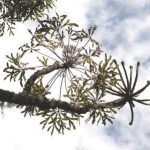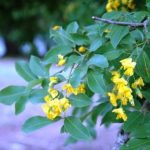TREE LIFE
July 1991
MASHONALAND CALENDAR
Saturday 6th July: Botanic Garden walk. Park your car at the Herbarium to meet Tom at 1045 hours for 1100 hours. Read Francisco and Cheryl’s acccounts of previous walks for revision as Tom will continue with figs.
Sunday 21st July: Ted and Anne Hatley whose farm is 104 kms from Harare are our hosts this month. Their farm “Kyle” is situated north-west of Harare, and although it is not situated on the Dyke, we are sure to see many of the Dyke species. There is a good chance that the Dyke aloe – Aloe orthalopha will be in flower.
Saturday 27th July: walk with Mark in the Mukuvisi woodlands, meeting in the main car park at 1500 hours.
Saturday 3rd August: 10.45 for 11 am. Botanic Garden Walk.
MATABELELAND CALENDAR
Sunday 7th July 1991: Off to Kloof Farm, Pasipas for a stumble along the hill behind Anne Visser’s homestead. To keep up with Harare we might even have a butterfly expert with us.
Morning only – meet at Falls Road Motors at 0830 hours – bring tea and chairs.
Wednesday 17th July 1991: McWHEW at Hillside Dams at 5.00 pm
Sunday 4th August 1991: To Heany Junction (turn-of 24 km Harare Road) – through the flowering aloes to Dr. Gelmans property for an all-day outing. Meet at Ascot Car Park (lifts already arranged) at 0830 hours.
Wednesday 21st August 1991: NOTE DATE for McWHEW owing to public holidays – Hillside Dam at 1700 hours.
Sunday 1st September 1991: Back to Bambata Cave area where we had so much success before – we have to exceed 81 species. Meet at Retreat at 0830 hours.
OBITUARY – JACK REID
With regret we have to record the death, at Borradaile Trust Marondera, of John Low (Jack) Reid.
Jack, in his 84th year, was one of the very, very few remaining founder members of this Society, past Chairman, and one of its three Trustees. A few years ago the Society extended to him the accolade of Honorary Membership.
A man of quiet authority and dignity, kindly and compassionate, he will he missed. Jack spent his life in this country, leaving only for brief periods to graduate at University and fight a war. Having qualified as a Surveyor at Rhodes University Grahamstown in the 1920’s, after attending the old St. George’s College in Bulawayo, he served an apprenticeship in commerce and thereafter joined the Public Service of Southern Rhodesia. He attained the top post in the Dept. of Lands, that of Director, and served in that capacity with distinction. It was an exacting job. Land distribution has always been a complex, politically confused, emotionally charged issue here, and Jack’s encyclopaedic knowledge of the legislation, his familiarity with almost every corner of the country, gained during many years of surveying and travel and his balanced and unruffled observations in the course of debate on administrative problems, won him the high regard of his staff and the admiration of Government ministries, Land Boards and farmer organisations.
Between 1939 and 1945 Jack saw service in East Africa and South East Asia, holding the rank of Major in his Surrey Unit. The Army failed to separate him by the many miles from his devoted wife, Judy, for she too went to E. Africa in the First Aid Nursing Yeomanry ( the FANY’s), and on to India when Jack was in Burma. They were often accused, teasingly, of course of “manipulating” the military authorities in order to go close together, and throughout their married lives this close bond was heartening to behold. It is, in fact, almost impossible to portray the one without the other.
Judy became very deeply involved in working for the blind at the Dorothy Duncan Home, and Jack’s unfailing support and encouragement in every phase, particularly in times of fatigue and distress, meant the world to her. Compassion can hurt when it is felt as deeply as these two felt it, not only for the blind but for all in travail. But they also shared the great pleasure of achievement in their work for others.
Despite their deep involvement in serious issues, they enriched the lives of friends with delightful shafts of humour, and their house was one of warmth and hospitality. A stay with them was a stimulant and a delight; outings and expeditions with them left the imprint of treasured memories.
Over the years they made a tremendous contribution towards the development of the Society. Committee work and secretarial work came within their orbit for years, and they attended meetings and meets with great regularity until age and infirmity intervened. But there was more. On projects which at one time featured prominently in the Society’s calendar, they spent countless hours working timelessly, without fuss or fanfare – not infrequently devoting part of Jack’s leave from office, to camp out on the project site. This occurred more specifically on the Lake McIlwaine Arboretum project, a mammoth undertaking so small a society, in which Jack’s expertise was vital to the pegging of contours and to certain other of the myriad tasks connected with the lay-out of water reticulation and the general implementation of the Arboretum scheme. They were associated with other projects also, the Mukuvisi woodland project for one but their concentrated and sustained involvement at McIlwaine was quite exceptional.
I know of no couple of whom it can more truly be said that cherished companionship (in their case through 53 years of married life) was enhanced by a shared love of the country side. They were conscious of its very feel, for they spent much of their lives camping in its vastness. They were sensitive to its moods, at dusk, at dawn, and in between. To them there was glory in the hush and then the sudden echoes of the stillness of the night; in the glorious freshness of the early morning. They gloried in the hills and streams; in their submission to the heavens in a storm, and their sparkle in the sunshine when the fury of the storm was spent; in the birds, the insects. . . in all their ways and wonders. They never ceased to marvel at it all; they never took it for granted; it was always new and always fascinating. They never lost the thrill of anticipation of the Msasa leaf’s pink flush at the dawning of new life in the spring; they found excitement anew each year in the tree pods bursting to scatter their seeds, and in the squirrel’s scampering appearance on the scene. They observed intently some of the seeming cruelties of nature, with predator and prey, but they observed with deep understanding. They had the gift of sharing all this with each other, and they loved to do so with friends and with relations. They were deeply grateful to be so blessed.
We said Goodbye to Judy not long ago. It is now time to close the chapter on that courteous, quiet and gentle soul, Jack.
-Dick Petheram
THE FAMILY MORACEAE (THE FIG OR MULBERRY FAMILY)
Before we look at the features discussed on the May botanical walk, it is worthwhile to have a look at the history and development of this family.
This family (whose family features were discussed in April) belongs to the sub-class Hamamelidae. The Hamamelidae stem directly from the archaic subclass Magnoliidae so they possess some of the generalised features e.g. use of tannin for defence and most of them retain the woody condition. The evolution of the Hamamelidae is very interesting. They developed wind pollination and reduced their flowers a long time ago where they developed (i.e. in the tropics) insects were already abundant, but from there, they moved to the temperate regions where insects had not arrived and being wind pollinated they became very successful without any competition from insect pollinated trees. Some plants however, particularly those in the Family Moraceae returned to insect pollination but the flower had become modified, it no longer resembled the generalised Magnolia flower. The Hamamelidae flower is borne on a catkin and more often than not the flowers are unisexual.
The Family Moraceae site close to the edge of the Hamamelidae. It derives it’s name from the genus Morus, the mulberry, which unlike the figs has retained wind pollination. The figs‘ pollination shows one of the most interesting relationships (symbiosis) of a plant and it’s pollinating insect. There are about 900 species of figs belonging to the genus Ficus alone, each of which is associated with a species of pollinating fig wasp in the family Apocrita of the order Hymenoptera (all the insects with a waist like bees). As the fig-wasp story is well known to most readers we will only look at some of the interesting features of this relationship.
Firstly the fig cannot let all its “fruits” be inhabited by wasps -as it would end up with no seeds and this relationship wouldn’t be worthwhile. It avoids this in two ways :-
a). In monoecious figs (this includes over 80% of Zimbabwean species), there is one type of fig which performs both seed and wasp production. This fig makes its flowers differentially suitable for oviposition through individual differences in style length and firmness. (Vertex 1988).
- b) Some fig species (e.g. F. capreifolia, F. exasparata, F. pygmaea and the cultivated fig, F. carica ) have two types of figs occurring on different trees. These figs are called gynodioecious. There are seed-producing figs and wasp-producing figs (gall figs). The seed figs contain only female flowers with long styles and the gall figs have both male and female flowers and wasps will emerge from these carrying pollen to the seed figs. The structure of flowers in seed flowers allow production of seeds upon fertilisation, while oviposition in gall flowers leads to wasp production. (Verterke 1987). In this way, the fig neither runs out of seeds nor wasps.
The female also participates in maintaining this relationship by regulating the sex of it’s offspring. It is of no use to produce a lot of males as males only fertilise the females inside the fig and never leave the fig to start a new generation in other figs. A female wasp would rather produce a lot of females which incidentally will produce offspring whether fertilised or not (parthenogenesis.) Female wasps have mechanisms for determining the number of females and males born (Martonetal 1986, Harvey 1986).
In this country there are about 23 species of figs. The Botanical Gardens have a nice collection of the whole family Moraceae, these plants illustrate the development that has occurred in the family especially in the flower i.e. it’s move from the simple catkin to the fully enclosed syconium. This month we looked at some of these developments.
Milicia excelsa ( was called Chlorophora excelsa)
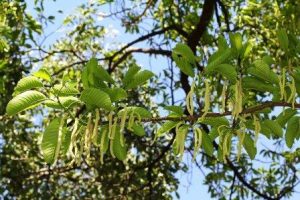
Milicia excelsa, Photo: Bart Wursten. Source: Flora of Zimbabwe
This is a timber tree exploited in Africa as it is a fast growing hardwood. It is very rare in this country, occurring in the Harone Valley where the only standing members occur on burial grounds, and the small population of less than 10 trees that grow along the banks of the Runde river in Gonarezhou. It may form part of the rain forest. The specimens in the Gardens were grown from seed sent out from Uganda and are some of the oldest trees planted in the gardens. A fine specimen occurs in the arboretum at Lake Chivero (formerly Lake McIlwaine). The flowers occur in male and female catkins that grow on different trees – only one of Tom’s specimens has ever flowered – we were fortunate to find male catkins, this specimen last flowered 4 or 5 years ago. Catkins are a general feature of the Hamamelidae.
Cardiogyne africana
Occurs in the Zambezi valley, the inflorescence is also a catkin. The flowers are like those of a fig but are not inside a syconium. It has anthers with bent elbows along the filaments, these help in pollen distribution. It has developed side branches which end in horns as a specialisation.
Dorstenia and Trilipisium madagascariensis
These both have half enclosed flowers, Dorstenia has reduced the number of flowers it bears and more interestingly it has become herbaceous, a specialised feature. It occurs in the Chirinda forest. T. madagascarensis has retained a woody condition it has a wide distribution and in the Burma Valley it forms an understory in Newtonia forests.
Ficus chirindensis
This is initially on epiphyte ( a plant growing on another plant) as it can not compete with other plants from the ground. The seed is placed on a branch by a bird and as the plant grows, it sends roots downwards and can eventually “strangle” the original tree (from where it derives it’s other name – Strangler fig). The tree at the Botanical Gardens was actually grown from the ground, showing that the plant does not necessarily grow as an epiphyte. This plant’s flowers are in fully enclosed syconia.
-Francisca Mutapi
BOTANIC GARDEN WALK Figs (genus Ficus) belong to the family MORACEAE (the mulberry family).
In Southern Africa there are only 6 genera in the family. All but Ficus are represented by only one species. The family is characterised by having a swollen receptacle bearing flowers and fruits. In the case of the real mulberry (Morus alba) flowers and fruits occur clustered on the outside of this receptacle. The figs have developed a receptacle which forms a hollow sphere, open to the outside by a small apical pore within this sphere the flowers then fruits develop, pollination being by minute highly specialised and adapted wasps.
The figs have alternate leaves and milky sap which may confuse them with Euphorbiaceae and Sapotaceae, but figs have distinctive stipules which leave leaf scars when they fall. The shape of stipule some times distinguishes different fig species. Figs seem to be in a constant state of reclassification and renaming, and some of them are, difficult for us to differentiate.
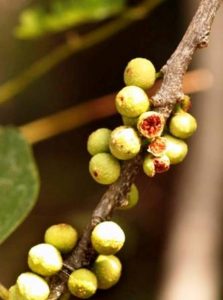
Ficus ingens. Photo: Petra Ballings. Source: Flora of Zimbabwe
Ficus ingens is widespread on stony or riverine areas, and is said to be indicative of a high water table. The longish leaf with white venation is characteristic. A spectacular specimen used to grow in the grounds of the Presbyterian church, but was felled in the ’70s – apparently large numbers of bats roosted in the tree, and the guardians of the faith could no longer put up with the streaks on the walls. We sadly collected a few fruit, and grew a number of trees which George Hall distributed to various farms, and one thrives in my garden.
F. ingens is similar to F. salicifolia (formerly pretoriae now included in F. cordatum. By whichever name you call it, this is the famous “wonderboom” near Pretoria. The original tree is estimated to be about 1000 years old, and over these years where branches have touched the ground they have rooted, to create a great complex under which several hundred people could shade themselves at one time.
F. salicifolia has much longer stipules than those of F. ingens . The figs of both are similar and are borne on younger side branches.
F. thonningii is perhaps the most common of our figs. If you have the 1977 Coates- Palgrave, look this up under “natalensis”, from which it has now been separated. There are many forms of thonningii, the one we most often see is as a strangler. However a mountain form has been recently identified, from the Chirinda Forest where it reaches over 50m, and often occurs in complex with F. natalensis. These two species are differentiated on differences in the figs and on the leaves which are truncated in natalensis. The forest thonningii in the gardens has prominent aerial roots.
Ficus sycamorus is very widespread, occurring from the Mediterranean to South Africa. In Zimbabwe it is most spectacular on low veld riverine alluvium. The leaves are hairy and almost as broad as long. Try the tongue-test on this one – guaranteed to set your teeth on edge unlike Ficus sur (formerly capensis). Most distinct is the bark which is greenish yellow.
Having milky sap means that the Figs have some medicinal importance (See the article on latex in plants, in last month’s newsletter). The milky latex is not toxic or corrosive like that of most Euphorbiae, but I can remember the latex from the figs of Ficus sur being used on warts when I was a child. I seem to remember that it didn’t work. Thank you Tom for another interesting walk.
-CHERYL HAXEN
McHEW — Wednesday. 12th June
Halohalohalo – Wot not Trees? No, not this month, we were different. Ian asked Alison Ewbank to give us a talk (illustrated with the usual photo copies) of Zimbabwe aloes. As the trees are becoming top-less, it was thought that with the weather/darkness closing in, and the aloes in full bloom this was an ideal opportunity – and unknown to us at that time it was also timely for our next outing!
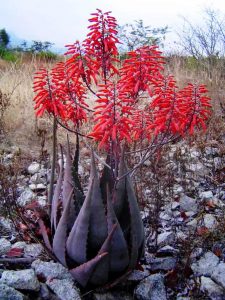
Aloe chabaudii. Photo: Bart Wursten. Source: Flora of Zimbabwe
We covered Aloe chabaudii, (also the verakeri variety – an import), A. globuligemma, A. aculeata, A. excelsa, A. greatheadii in comparison with the A. zebrina . A thoroughly interesting and informative evening – thank you very much Alison – ooh! and Ian!
AND – EASTERN MATOPAS REVISITED
A miserable morning (and an “extra”) brought forth a few real enthusiasts for what turned out to be one of the best outings of the year.
Our destination was the little known Lumane Falls on the eastern fringe of the Matopos, and turning off the Gwanda Road towards Diana’s Pool the rough road was soon forgotten in the excitement of the wide views down the Umzingwane escarpment and the many colourful aloes along the way. From Ezibomvu the road improved and so too, the acres and acres of wild aloes – A. chabaudii, A. excelsa, A. greatheadii, and A. aculeata giving breath taking colour at every corner to the magnificent scenery.
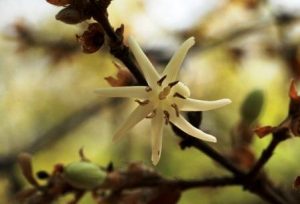
Sericanthe andongensis. Photo: Bart Wursten. Source: Flora of Zimbabwe
Jill and Data were leading and at an anthill in the middle of nowhere, turned left between two mealie fields and continued for about 3 km to a natural “lawned” area on the banks of the clear running waters of the Lumane River, surrounded by magnificent stands of Brachystegia glaucescens, Pterocarpus angolensis and P. rotundifolius, Heteropyxis dehniae, Croton gratissimus, Euphorbia ingens and Julbernardia globiflora. The 20 minute walk along the river bank brought to light Ficus sur, Kirkia acuminata, Strychnos matopensis ( with its chameleon tail-like tendrils, our newly discovered Vepris reflexa, Sericanthe andongensis (complete with their “catherin wheel” flowers), Maytenus heterophylla and hiding away in the undergrowth, the puberula subspecies, a perfect bonsai of Ficus tettensis struggling through a crack in the rock, Acokanthera rotundata just finishing flowering, but the stiff rough round leaves looking beautiful, and Bridelia mollis and Combretum molle showing how soft nature can be.
As we walked along, the hundreds of red-wing starlings made it seem like an aviary and we could hardly wait to get to the top of the falls (about 400 ft deep) to stand among the Cussonia spicata var. triptera, Barleria stellata, Brachylaena rotundata, Faurea saligna and Rhus leptodictya, to look on to the Falls and the edge of the world, before I realised that I suffer from vertigo! Across the chasm a Cussonia natalensis was a lone yellow tree in the vista of Brachystegia glaucescens and scenery.
On the way back for lunch with the sun shining brightly from a clear sky, we stumbled across a small Ziziphus mucronata (ouch!) and Tetradenia brevispicata (smelling of ginger), the enormous leaves of the peeling bark Pavetta eylesii, another ouch – Euphorbia griseola, Euclea natalensis and E. divinorum, Cordia grandicalyx and the red-stemmed Catha edulis.
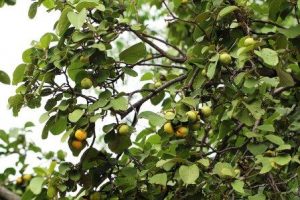
Cordia grandicalyx. Photo: Bart Wursten. Source: Flora of Zimbabwe
Ah, lunch, supplied by Clem, was eaten whilst admiring the redwing seeds of Pterolobium stellatum and the large white flowers of Protea gaguedi, serenaded by baboons and dassies and a beautiful gliding augur buzzard. That part of the outing finished, we left for Diana’s Pool, luckily an undamaged sacred place, and to an exciting national monument (No. 136) – the Orbicular Granite, looking like enormous tortoise shells – an amazing sight in the stream bed among the Mimusops zeyheri, Combretum zeyheri, Ehretia rigida, Albizia amara, Olea europaea subsp. africana and Myrothamnus flabellifolius resurrection plants, and overlooked by more Aloe chabaudii and Euphorbia cooperi.
Our enjoyment of the outing was heightened by showing this part of Matabeleland to two Shona-turned-Matabele members, Dave Winhall and Elspeth Bailey (EB) of Chikwenya Tree-life articles fame. It was fabulous to have them with us unexpectedly, and made us appreciate all our usual trees all over again.
A wonderful outing, to be repeated some time next year (also to a patch of Cyathea dregei – a tree fern) at a different time perhaps, but which will then lack the magnificent colourful aloes making this a most memorable day.
-KEN BLAKE
MATABELELAND BRANCH : SUNDAY JUNE 2nd. Stonehills Farm: Marula
We arrived at the workshop to find that we were minus three vehicles. Ken nobly drove off to look for the lost sheep and upon his return, we spent a short while in a portion of the woodland on the perimeter of the cleared area at the base of a kopje finding nineteen species. It was of particular interest to see Cussonia arborea once again, looking very striking with leaves turning an autumnal yellow.
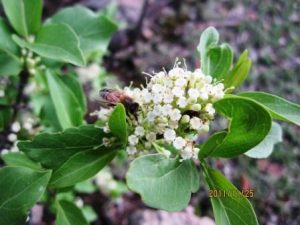
Psydrax livida. Photo: Rob Burrett. Source: Flora of Zimbabwe
From the workshop we walked a short distance further along the road, then climbed a dwala from which we had a magnificent view of the greater part of the farm. Fortunately Geoff was with us, being able to identify Psydrax livida and Vepris reflexa. We refreshed our memories on Acokanthera rotundata and Tarchonanthus camphoratus and saw Euphorbia cooperi and ingens. We sampled the fruit of Ficus sur before traversing the vlei, skirting the first hill on the far side and heading for the next rocky outcrop; at some time having a good view of the three newly introduced giraffe in their paddock and in the distance, wildebeest, zebra and eland. Les Broughton sounded reluctant to do any climbing, the Maleme Tree walk being too fresh in his memory no doubt. Despite his fears we were soon up the kopje over the top down the other side and out on the open plain, though not before having to call upon Geoff to identify Buddleja saligna and Hexalobus monopetalus. A short walk took us past the game from the rear, through a wooded area where a Strychnos matopensis was in colourful fruit and brought us full circle to the workshop.
After lunch our host, Richard Peak, lead our convoy as we drove to a second valley where he hoped we might rediscover an Erythrophysa transvaalensis. Unfortunately we were unsuccessful but Dennis was pleased to see that in addition to Acacia rehmanniana there were Acacia gerrardii, karroo and nilotica on the approach to the stream. We headed up the valley into the tree line, skirted the grassland on the northern section then followed the road along the fence line back across the vlei on the eastern sector. The Maytenus senegalensis in full flower was looking most attractive as was Protea gaguedi.
As we looked back across the valley we saw a herd of Tsessebe running through the trees. Earlier we had stopped to watch a black breasted snake eagle. A quick tea break and away to the city; bringing to an end yet another rewarding outing on which we recorded 86 species and found one unknown. Particularly remarkable was the greeness of the trees, unlike Bulawayo where many of the indigenous trees are leafless.
Thank you Richard and Bookie.
-MARGARET MCCAUSLAND
NGOMAKUHIRA – SUNDAY 16 JUNE
It was a beautifully warm day and a most unusual Tree Society Outing. We met at 8.30 am and walked for most of the day! There is a great variety on the lower slopes, including Acacia goetzei subspg, microphylla (the Matepatepa farmers taught us that one, Euphorbia matabelensis and Commiphora mossambicensis, both without leaves at this time of year. I am still not happy about the difference between Monotes glaber and Monotes engleri but I think we saw both during the day. Phil and Cheryl came across an Albizia versicolor (confirmed as such) which was not as hairy as usual. Myrica pilulifera and Oxyanthus speciosus are two Eastern Districts species which grow here in the kloofs.
We reached the top by various routes and lunch was a record half hour at the beacon. Bourneville (yes the colour of chocolate) and pup entertained us by eating the lettuce out of lettuce sandwiches. Returning via the main water course (no water in the upper reaches and so few ferns, unfortunately) brought us to the Syzygium forest. This sub species has a pronounced drip tip, making it look like an Eastern districts tree too. Cussonia congesta and Nuxia congesta were other interesting finds in this region.
Lower down we stopped at the stream to inspect sundews (Drosera sp) and to admire the carpet of yellow flowers. They were identified as Utricularia prehensis. The small mauve “erica” also growing in the mud was in fact Polygala africana.
Our thanks to Raymond from the Mukuvisi woodlands who took us around his home ground and to George who organized the trip.
-Tessa Ball
NYAHUPINDA CATCHMENT JUNE 1991
The Scene. Rainfall For the season was 506 mm. As if to make amends for the abrupt end of the rains on March 30th, there were showers and thunder in mid May. Winter began on June 1st. Colour has gone from the grass, many trees are leafless on the kopjes but woodlands are predominantly green.
It is the marmalade season and sometimes the aroma of Seville oranges fills the house.
In “Tree Life” No. 136 it was appropriate that “Happy Treeing the Milky way” was followed by news of the Zambesi Society Shop behind the Dairy Den at Chisipite. Mention of the Zambesi is a fitting introduction to the ecological tapestry (needlepoint). .
Elephant Country
Inspiration came from an Erhman tapestry design from overseas which depicted Indian ‘elies’ surrounded by stylised leaves and flowers. The writer has attempted to change the scene to Africa; profiles of a bull and cow African Bush Elephant were set on a background of Mana and the hills of Zambia, they were surrounded by a flowing border of plants, here is a list of them: l. Adansonia digitata leaves flower and one fruit; 2) Colophospermum mopane leafy twigs and fruit; 3. Commiphora pyracanthoides, leafless spiny twigs with ripe berries; 4. Faidherbia albida, zigzag branchlets bearing pods; 5. Friesodielsia obovata, leaves and a cluster of red ‘sausages’; 6. Jatropha podogrica; 7. Kigelia pinnate, leaves, inflorescence, peduncle with ‘sausage’; 8. Sclerocarya birrea, leaves and fruit; Strophanthus kombe russet leaves, tail flowers and one great grandfather’s moustache fruit.
The list shows some species which have pinnate leaves and others with small ‘berries’, these needed artist’s licence to adapt them for needlework. Improvements to the prototype will be simplification of design and to enlarge it from 32 cm. square to a 36cm. square.
Number 6 on the list comes from central America, it is known in Zimbabwe as Kariba Bottle Plant. Its bold outline and brightly coloured inflorescence helped to balance the design.
Except for species numbered 3, 6, 9, the others occur naturally in this catchment and along the Mukwadzi river approximately 16km distant on Perth farm. The presence of nos. 2 and 4 at this altitude 1000m – 1250m) is unexpected. It has been suggested that “parrots brought the ‘Acacia’ seed. Mention of Perth farm brings the Horse Safari to mind. This event lacked the enthusiasm of Tree Society outings. It has taken many visits to this place to collect 100 ticks on the field card of trees and shrubs, the Safari added Combretum apiculatum found in open woodland on a stony hillside, (Kelvin Hein was right about this), and Diosprios squarrosa, more easily remembered as square-rosa ( a hint from Maureen) which had thin straggling branches, much more angular than its dignified relative D. kirkii. The birding part of the day was disappointing as regards first calls and sightings; Natal Francolin were noisy near the Mukwadzi, there was a Hammer kop’s voice -in the distance, do the openings of their nests always face the same way?
Tree Mapping
General reference “Tree Life” No. 109, and in particular No. 130.
At the time that the transect line was recorded for “Operation Catena” it was not appreciated that it would be invaluable for Tree Mapping. Whilst following a line of this kind it may facilitate seeing and recording everything.
A Master Field Card of Trees and Shrubs
This gives another dimension to the check list. The environment of each species found is given a symbol, this is put in the F/S box. Some boxes contain several symbols, e.g. Lannea discolor, Julbernardia globiflora and perhaps Diplorhynchus condylocarpon . This is an ‘aide memoirs‘.
In this Catchment the environments symbolised are: woodland sandy, woodland clay, grassland, kopje, stony hillside, termite mound, riverine, vlei margin, seepage/depression
To conclude, the Bauhinia galpinii and Duiker Tree are doing well, thank you to Dave and Sue du Plessie. To Kim, all the best and come back soon.
-Benedicta Graves
At the Annual General Meeting in May, the outgoing Committee was re-elected en bloc with two additions. The Committee is :-
Kim Damstra Chairman
George Hall Vice Chairman
Joy Killian Treasurer
Violet Siebert Membership Secretary
Maureen Silva-Jones Secretary
Fiona Dawe
Tessa Ball
Andrew McNaughton
Vera Neil.
The Chairman’s report will be published on his return to Zimbabwe.
Roll-call of the Assembled Beings – From the Soil
I am the Living Earth. I am the softened tissue of rocks, baked by the sun, split by ice, carved by water, and winnowed by the wind. I am interwoven by myriads of tiny plants and animals that pulse and breathe. I am the invisible universe of sparkling molecules in the infinity of living soils that bless the mantle of the globe.
I am the carpet of the biosphere, the floor of the forest, the seed bed of all plants, and my living substance nourishes all roots and all leaves that rely on the sun and rain to make green sculptures out of clay. In the tall dim damp rain forests I house the bulk of animal life, and support the endless upwards toiling of trees and coiling of vines. I am the bottom line of all grand symbiosis in forest biology. I am the source of mineral molecules in lovely flowers born high among the birds in the forest canopy. I am the energy sink, the lovely muddy frugal cemetery for recycling all the forest’s elements in the transitions between life and death.
Touch me, smell me, I am your ultimate quality of life in ecology’s profound cycles. See me, hear me, you humans who pass me by with your round computer heads rocking in the forest sky above me. Spare me a thought, you humans who depend on me, remember me, as I die before you, when you take away my forest coverings and still the microbes that give me life, me the Living Earth.
Shift your gaze sometimes from the stars and remember the heaven beneath your feet. Remember me when the sun burns and the waters gouge me, be kind to the forests that remain, and protect them from senseless cuttings. Remember, like me, you are already eroding. Know this, like me, you are only dust when you are dead. Accept this, unlike you, I am closer to re-creation as the living earth to genesis.
-Len Webb. 9.2.89
KIM DAMSTRA CHAIRMAN


